Crassula perfoliata var. minor
| Botanical Name | Crassula perfoliata var. minor |
|||||||||||
| Family | Crassulaceae - The crassula family. |
|||||||||||
| Pronunciation | KRASS-yoo-la per-foh-lee-AY-tuh var. MYE-nur |
|||||||||||
| Common Name(s) |
English: Propeller Plant; Scarlet paintbrush
Afrikaans: Sekelblaarplakkie; Heuningbossie
|
|||||||||||
| Plant Group |
|
|||||||||||
| Plant Size |
|
|||||||||||
| Position |
|
|||||||||||
| General Information |
|
|||||||||||
| Specific Information | Even when not in flower, Crassula perfoliata var. minor is an eye-catching plant of interest in the garden. The grey-green leaves are sickle-shaped, firmly succulent, and arranged in opposite rows, compressed on opposite sides. The leaves often have red markings on the surface and minute teeth on the edges of the leaves. When in flower it makes an outstanding focal point. Crassula perfoliata var. minor is not often encountered in the veld as it has a limited distribution and grows in inaccessible places where it is well protected. Frost is rare or absent. The plant is grown by succulent plant lovers all over the world.
|
|||||||||||
| Ad Break | ||||||||||||
| Flowers | ||||||||||||
| Description | densely clustered tiny bell-shaped flowers with bright yellow stamens arranged in a rounded to flat-topped head, held well above the plant |
|||||||||||
| Season |
|
|||||||||||
| Colour |
|
|||||||||||
| Growth Rate |
|
|||||||||||
| Plant Uses |
|
|||||||||||
| Distribution and Habitat | from the Groot Winterhoek Mountains and Port Elizabeth to Umtata in the Eastern Cape Province, on cliffs along dry river valleys and on quartzite sandstone outcrops in grasslands |
|||||||||||
| Planting Suggestions | Crassula perfoliata var. minor grows and flowers best in dry gardens where frost is absent or mild. It is best planted in rockeries in full sun. Soil must be well-drained and sandy. Where frost is experienced, it needs the protection of a greenhouse, windowsill or patio. The plant can be propagated by division (which is quick), leaf cuttings (slow) or seed. Leaf cuttings can be made during spring or summer and rooted in clean, moist sand. |
|||||||||||
| Medicinal Uses | The plant is not used medicinally, but is grown by succulent fans across the world. |
|||||||||||
| Ad Break | ||||||||||||


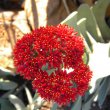
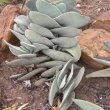
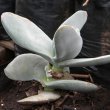
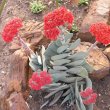
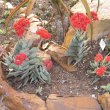




Discuss this plant
Share knowledge, ask a question or give an experience.